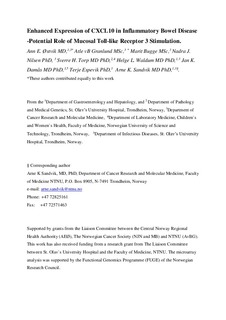| dc.contributor.author | Østvik, Ann Elisabet | |
| dc.contributor.author | Granlund, Atle | |
| dc.contributor.author | Bugge, Marit | |
| dc.contributor.author | Nilsen, Nadra | |
| dc.contributor.author | Torp, Sverre Helge | |
| dc.contributor.author | Waldum, Helge | |
| dc.contributor.author | Damås, Jan Kristian | |
| dc.contributor.author | Espevik, Terje | |
| dc.contributor.author | Sandvik, Arne Kristian | |
| dc.date.accessioned | 2017-11-02T12:58:35Z | |
| dc.date.available | 2017-11-02T12:58:35Z | |
| dc.date.created | 2013-01-15T18:44:23Z | |
| dc.date.issued | 2013 | |
| dc.identifier.citation | Inflammatory Bowel Diseases. 2013, 19 (2), 265-274. | nb_NO |
| dc.identifier.issn | 1078-0998 | |
| dc.identifier.uri | http://hdl.handle.net/11250/2463728 | |
| dc.description.abstract | We explored the gene expression in colonic biopsies of active and inactive inflammatory bowel disease (IBD), in an extensive material of ulcerative colitis (UC) and Crohn`s disease (CD). The chemokine CXCL10 and its receptor CXCR3 were among the upregulated genes. This study examines the expression of CXCL10 and the mechanisms for its release in patients with UC or CD, and in intestinal epithelial cell (IEC) lines.
Methods: A microarray gene expression analysis was done on colonic biopsies (n= 133) from patients with IBD. Biopsies were studied with immunohistochemistry for CXCL10 and CXCR3 expression. Mechanisms for CXCL10 release in peripheral mononuclear cells (PBMCs) and in the colonic epithelial cell lines HT-29 and SW620 were studied upon pattern recognition receptor (PRR) stimulation.
Results: CXCL10 and CXCR3 mRNA abundances were increased in biopsies from active UC and CD compared to inactive disease and controls. CXCL10 was mainly localized to mucosal epithelial cells, with increased immunostaining in active IBD. CXCR3 positive cells were scattered in the lamina propria. CXCL10 was secreted from the colonic epithelial cell lines, in response to the toll-like receptor 3 (TLR3) ligand polyinosinic: polycytidylic acid (poly(I:C)). This ligand also induced a marked release of CXCL10 in PBMCs from IBD patients and controls.
Conclusions: We identify CXCL10 and CXCR3 as upregulated genes in colonic mucosa in active IBD. The TLR3-ligand poly(I:C) markedly increased release of CXCL10 in colonic epithelial cell lines, suggesting a TLR3 (dsRNA) mediated CXCL10 release from mucosal epithelial cells in IBD patients. | nb_NO |
| dc.language.iso | eng | nb_NO |
| dc.publisher | Lippincott, Williams & Wilkins | nb_NO |
| dc.title | Enhanced expression of CXCL10 in inflammatory bowel disease: Potential role of mucosal toll-like 3 receptor stimulation | nb_NO |
| dc.type | Journal article | nb_NO |
| dc.description.version | submittedVersion | nb_NO |
| dc.source.pagenumber | 265-274 | nb_NO |
| dc.source.volume | 19 | nb_NO |
| dc.source.journal | Inflammatory Bowel Diseases | nb_NO |
| dc.source.issue | 2 | nb_NO |
| dc.identifier.doi | 10.1002/ibd.23034 | |
| dc.identifier.cristin | 989383 | |
| dc.relation.project | Norges forskningsråd: 223255 | nb_NO |
| dc.description.localcode | This is a submitted manuscript of an article published by Lippincott, Williams & Wilkins for Crohn's & Colitis Foundation of America, Inc. in Inflammatory Bowel Diseases, 8 June 2012 | nb_NO |
| cristin.unitcode | 194,65,15,0 | |
| cristin.unitname | Institutt for klinisk og molekylær medisin | |
| cristin.ispublished | true | |
| cristin.fulltext | preprint | |
| cristin.qualitycode | 2 | |
